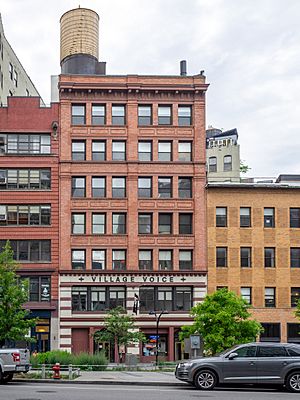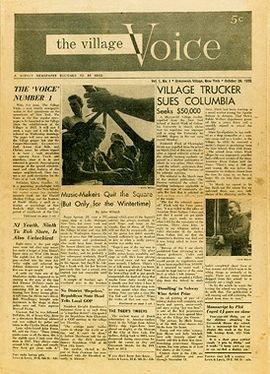The Village Voice facts for kids
 |
|
| Type | Alternative weekly |
|---|---|
| Format | Tabloid |
| Owner(s) | Brian Calle |
| Founder(s) |
|
| Founded | October 26, 1955 |
| Ceased publication | August 22, 2017 |
| Relaunched | April 17, 2021 |
| Headquarters | 36 Cooper Square New York City 10003 U.S. |
| Circulation | 105,000 (as of 2017) |
| ISSN | 0042-6180 |
The Village Voice was an American newspaper. It was famous for being the first "alternative" newspaper in the country. This means it offered different viewpoints from mainstream news. It covered news and culture.
The Voice was started in 1955 by Dan Wolf, Ed Fancher, John Wilcock, and Norman Mailer. It began as a place for creative people in New York City to share their ideas. The paper stopped printing in 2017, but its articles stayed online. After a new owner took over, the Voice started printing again in April 2021. It now comes out four times a year.
Over 63 years, The Village Voice won many awards. These include three Pulitzer Prizes. It also won the National Press Foundation Award and the George Polk Award. Many famous writers and artists worked for the Voice. These included Ezra Pound, Lynda Barry, Greg Tate, and film critics like Andrew Sarris.
In 2015, The Village Voice got a new owner. It separated from its old parent company. On August 22, 2017, the Voice announced it would stop printing. It would become a digital-only newspaper. The last printed paper came out on September 21, 2017. It had a photo of Bob Dylan on the cover. The Voice continued to publish new stories online until August 2018. Then, in December 2020, it was announced that new articles would be published again. Both online and in print. The first new print edition came out in April 2021. The Voice website still has old articles that are useful today.
Contents
History of The Village Voice
How the Paper Started
The Village Voice began on October 26, 1955. Ed Fancher, Dan Wolf, and Norman Mailer started it. They worked from an apartment in Greenwich Village. This area was where the paper first focused. By the 1960s, it covered more of New York City.
The paper moved offices several times. It started at 22 Greenwich Avenue. Then it moved to 61 Christopher Street in 1960. Later, it moved to Cooper Square in 1991. In 2013, it moved to the Financial District.
Early Writers and Columns
Many writers worked for the Voice in its early years. Jonas Mekas wrote about underground films. Linda Solomon wrote about the music scene. John Wilcock wrote a column every week for ten years. Cartoonist Kin Platt drew weekly pictures of theater actors. Other important writers included Peter Schjeldahl and Ellen Willis. In 1977, the staff of the Voice formed a union.
For over 40 years, Wayne Barrett was a special reporter. He investigated real estate and politicians in New York. This included Donald Trump. His reports are still helpful for reporters today.
Awards and Special Features
The Voice wrote about New York City politics. It also covered national politics. It had reviews of arts, culture, music, dance, film, and theater. Writers and cartoonists for the Voice won three Pulitzer Prizes. Teresa Carpenter won in 1981 for feature writing. Jules Feiffer won in 1986 for his cartoons. Mark Schoofs won in 2000 for international reporting.
The paper also gave out the Obie Awards. These awards recognized alternative theater in New York. The "Pazz & Jop" music poll was very popular. Robert Christgau started it in the 1970s. It was a survey of music critics. In 1999, a similar poll started for films. The Voice also held a free music festival called Siren Festival. It later became the "4knots Music Festival."
In New York City, other papers like The New York Observer were competitors. In 1996, the Voice became a free newspaper. Before that, people had to pay for it. The Voice website won awards too. It won the National Press Foundation's Online Journalism Award in 2001.
In 2005, a company called New Times Media bought the Voice. They then changed their name to Village Voice Media. Many different owners have had the Village Voice. These include its founders and Rupert Murdoch.
Changes in Ownership
When New Times Media bought The Village Voice in 2005, many leaders changed. Two journalists from Phoenix, Arizona, managed the paper. Over the next few years, several editors and writers left or were let go. This included long-time music critic Robert Christgau. Nat Hentoff, who worked there for 50 years, also left. Wayne Barrett, a reporter since 1973, was laid off in 2011.
In 2012, some executives bought the papers from Village Voice Media. They formed a new company called Voice Media Group. In 2013, the editor and deputy editor quit. They did not want to lay off more staff. After they left, three long-time writers were fired. These included Michael Musto, a gossip columnist. Michael Feingold, a theater critic, was rehired in 2016. Michael Musto also returned in 2016 and again in 2021.
In 2015, Peter Barbey bought The Village Voice. He is from a wealthy family. His family also owns the Reading Eagle newspaper. After buying the Voice, Barbey appointed new leaders. Joe Levy became interim editor. Suzan Gursoy became publisher. In 2016, Stephen Mooallem became editor-in-chief. He resigned in 2018.
On August 31, 2018, it was announced that the Village Voice would stop publishing. Half of its staff were laid off. The remaining staff worked on archiving old articles. John Wilcock, one of the co-founders, died two weeks later.
The Return to Print
In January 2021, new articles started appearing on The Village Voice website. On April 17, 2021, the Spring 2021 issue was printed. It appeared in news boxes and on newsstands. This was the first time since 2018. Now, The Village Voice is published four times a year.
Who Wrote for The Voice
The Voice published works by many famous writers. These include Ezra Pound, Henry Miller, and James Baldwin. Other notable contributors were E.E. Cummings, Nat Hentoff, and Allen Ginsberg. Former editors include Clay Felker.
The newspaper also featured underground cartoonists. Jules Feiffer had a cartoon in the paper for decades. Other well-known cartoonists included R. Crumb, Matt Groening, and Lynda Barry.
See also
 In Spanish: The Village Voice para niños
In Spanish: The Village Voice para niños
- Gear (The Village Voice)
- Media of New York City
- List of underground newspapers of the 1960s counterculture



